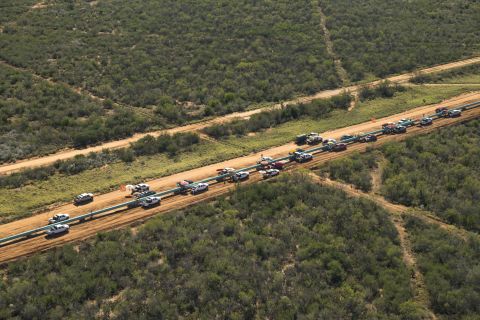
Alberta’s Cardium formation is in the midst of a tremendous renaissance, thanks to unconventional production technologies. “It’s truly remarkable what is available to us,” said Murray Nunns, president and chief executive officer, PennWest Exploration, speaking at Hart Energy’s inaugural DUG Canada event in Calgary. PennWest controls 600,000 acres of land, about 40% of the total trend, in the Cardium. Its position is largely concentrated in the old fields.
The Cardium is a long-time producer that was discovered in 1953. Today it has about 4,000 vertical wells and 1,100 water injection wells and has made 1.8 billion barrels of oil equivalent (BOE) to date. Current average recovery of oil in place is 10% to 15%.
“You have to understand the past ,” said Nunns. “It was mainly the advent of vertical fracturing that opened up this field.” After heady days in the early 1970s, when volumes peaked at 200,000 BOE per day, by 2008 Cardium trend production had slid down to 50,000 BOE per day.
Remarkably, in the past 18 months operators have added some 70,000 BOE per day and completely reversed the production decline of the light-oil reservoir. The changes were wrought by a combination of technology, royalty relief and regulatory approvals. On the technology side, horizontal drilling and multi-stage fracturing techniques were adapted from shale gas and sized and shaped to the tight Cardium, and this allowed producers to access more reservoir at lower cost. The Alberta government also greatly lowered up-front royalty rates, which boosted rates of return. Finally, regulators at last allowed downspacing from the 80-acre-plus scheme of past decades.
The Cardium is composed of fine-grained sands, siltstones, shales and isolated conglomerates that occupy a place on the continuum between conventional and unconventional reservoirs. Current drilling targets different play concepts: wells are drilled in the interior of the old field; distal edges or halos are tapped; and wells are being aimed at tighter sands that lie below the main Cardium interval.
But the biggest prize could be something new, the bold frontier of secondary recovery in unconventional reservoirs: “We believe there is ultimately a great combination of horizontal technology and waterflooding that can be married together in this field,” said Nunns.
The Cardium area is very large, so reservoir depths and conditions change throughout. But in general, wells recover between 150,000 to 250,000 BOE apiece, for capex of C$2.3 to C$4.8 million. “What sets the Cardium apart is its scale,” said Nunns. “It’s massive.”
About 10% of Canada’s rig fleet is currently working in the Cardium. To date, 1,500 horizontal wells have been drilled, and 1,000 of those have reported production.
“We are just scratching the surface,” Nunns said. “Up to 17 billion BOE remain in place, and we think there is another 1.1 to 2.6 billion BOE of potential recovery, at C$20 a barrel finding cost.” That includes primary and secondary recovery both--PennWest estimates that 5% to 10% of the remaining in-place oil will be recovered by primary methods and another 5% to 10% could be recovered by waterflood.
“Also, we ultimately think there could be a CO2 leg, and we’ve done enough experiments to believe it can be done and should be done at some point,” he said.
“The beauty of this one, as a brownfield case, is that we have the numbers to work with. We have a tremendous amount of information. We have hundreds of cores and we absolutely have a feel for what we are doing. The pace of this is only going to pick up.”
The Cardium has already produced 1.8 billion BOE, and although the field is nearly 60 years old it has the potential to produce at least 1 billion more.
Source: PennWest Exploration, Hart Energy’s DUG Canada 2012 Conference
Recommended Reading
Private Midstream Executives: More M&A, More Demand, More Gas Pricing Woes
2024-10-17 - Private midstream CEOs discuss the growth, opportunities and challenges that lie ahead.
Energy Transfer Leads the Midstream Consolidation Flow
2024-10-01 - Energy Transfer co-CEOs discuss pipeline pain points, needed M&A, regulatory woes and much more in this Midstream Business exclusive.
Energy Transfer Shows Confidence in NatGas Demand with Pipeline FID
2024-12-11 - Analyst: Energy Transfer’s recent decision to green light the $2.7 billion Hugh Brinson line to Dallas/Fort Worth suggests electric power customers are lining up for Permian Basin gas.
Analysts: A Growing Bakken Will Require a Stronger Pipeline Network
2024-11-06 - East Daley looks at potential courses as the basin continues to increase production.
Permian Resources Divests Delaware Basin Midstream Assets to Kinetik
2024-12-10 - The deal includes approximately 60,000 gross operated acres dedicated by Permian Resources under long-term, fixed-fee agreements for natural gas gathering, compression and processing and crude oil gathering services, Kinetik said.
Comments
Add new comment
This conversation is moderated according to Hart Energy community rules. Please read the rules before joining the discussion. If you’re experiencing any technical problems, please contact our customer care team.





